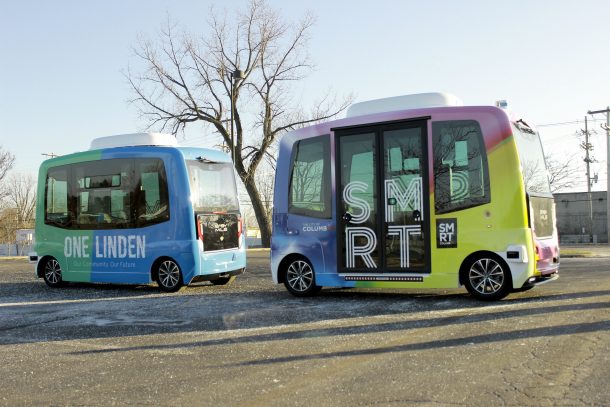Hoping to reconnect the South Linden neighborhood with the rest of Ohio’s capitol, the city of Columbus has launched an electric shuttle program funded primarily by the federal government. The municipality frames it as the first daily, public residential autonomous shuttle to be operated by an American city. While other U.S. towns exist that would definitely disagree with the claim, Columbus may be the first to run a self-driving shuttle seven days a week on the government’s dime.
Service began Wednesday, with the three-mile route open to all residents free of charge.
As the sole recipient of a $40 million USDOT grant tied to the Obama administration’s Smart City Challenge, Columbus opted to use EasyMile EZ10s for the project. They’re about what you’d expect — generic electric boxes with a small footprint and loads of headroom. The city received another $10 million from the Paul G. Allen Family Foundation, which acted for seed money for Smart Columbus’ Linden LEAP shuttle program.
However, the Smart City initiative was more about encouraging developing towns to experiment with new mobility solutions than simply hooking one up with a new bus route. Smart Columbus also wants to find better ways of networking transit schedules, adopt more last-mile vehicles (bicycles, e-scooters, etc.) for public use, and build its EV charging network. Autonomous shuttles just happen to be higher profile and more expensive, making their postponement less appetizing.
The shuttle service will last 12 months and carries a price tag of $1.13 million. Columbus says Linden LEAP aims to find ways to get underserved populations where they need to go, noting that the route stops at Saint Stephen’s Community House. The location provides childcare, senior care, a food bank, and additional services (e.g. healthcare, community outreach) to the local neighborhood.


“Saint Stephen’s was largely disconnected from transit,” Jeff Kupko, an engineer with Michael Baker International who served as project manager for Smart Columbus, explained to Bloomberg. “Some people were limited in the amount of food they took from the food pantry because it was too far to walk to the bus.”
From Bloomberg:
Last week, Kupko was at St. Stephen’s, making final tweaks to the EasyMile EZ10 shuttle buses. The vehicles, which cost $320,000 each, are configured to hold about 12 people and run 14 hours on a single charge through all but the most extreme temperatures. They can operate at Level 4 autonomy, meaning full autonomy with the ability for an onboard operator to take control (there’s no steering wheel or brake pedal, just a double-joystick controller).
Short of an emergency, “operators will help with wheelchairs, strollers, general wayfinding and act somewhat as a brand ambassador for the shuttle and Smart Columbus,” Kupko said.
The National Highway Traffic Safety Administration wrote special rules to govern Linden LEAP. Vehicle speeds are limited to 25 miles per hour; shuttles must stop service for 90 minutes twice daily as neighborhood schools welcome or dismiss students; and the lidar-equipped shuttles must stay on a designated route.
That should work out fine, as the EZ10 shuttles only have a 30.72-kWh battery and can run for about 16 hours per day. Those batteries can get a top-off while the youngsters make their way home, requiring just a couple of hours of nightly recharge to be fresh for the next morning.
As with the May Mobility shuttles in Providence, Rhode Island, Columbus’ colorful baby buses (thanks to the rainbow paint job) will be interesting to watch. Ohio’s capitol has dabbled with May Mobility before, fielding a few of its AVs so they could learn the roads, but it appears to be sticking with EasyMile on the Linden project. The city will undoubtedly spend the rest of 2020 trying to keep tabs on how the shuttles are performing, tallying ridership, and hoping to figure out a way to make it all work on a micro level in order for macro-level testing to become feasible.


[Image: Smart Columbus]





